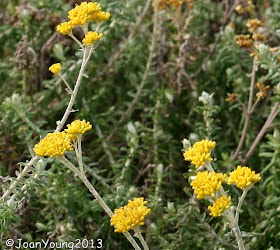Family Asteraceae
DescriptionHelichrysum cymosum subsp. cymosum is a fast growing, well branched, spreading groundcover that can grow up to 1 m tall, but in the garden it is usually about 500 mm tall with equal spread. It has thin greyish-white woolly branches densely covered with leaves. The leaves are variable, mostly 8–15 (–42) x 2–4 (–15) mm, becoming smaller and more distant upwards. The upper surface of the leaf is covered in thin silvery grey, paper-like hairs (indumentum) that will strip like a skin when rubbed.
It flowers during summer, between September and April, but mainly in late summer and autumn, with bright canary-yellow flowers in flat-topped flowerheads that look like masses of small discs. Each flowerhead is a cluster of 6–20 flowers. The flowers generally have smooth tips, and a pappus of many bristles (a pappus is a whorl or tuft of bristles in place of a calyx).
There are two recognized subspecies of Helichrysum
cymosum : subsp. cymosum and subsp. calvum which occurs
mostly in the Grassland Biome. It ranges along the Drakensberg from the Eastern
Cape region, along the KwaZulu-Natal and Lesotho border to the low Berg in
Mpumalanga. The two subspecies can be confused but the difference between them
is that subsp. calvum has smaller flowerheads with fewer flowers per
flowerhead (4–7 flowers), generally narrower leaves, and it lacks a pappus
Distribution and habitatIt grows in big straggling clumps, often in moist areas such as the hollows between dunes, amongst shrubs in Cape scrub and on forest margins. It ranges from the Western Cape, including the Cape Peninsula, eastwards along the coastal mountain ranges of the Eastern Cape and as far as Lake St Lucia in KwaZulu-Natal.
Like in many other Helichrysum species, the leaves are aromatic. Traditionally, people of the Eastern Cape use dried leaves as a pain reliever, by inhaling the smoke of burning leaves. Fresh leaves are traditionally boiled in water and drunk as a tea for coughs and colds. Leaves are also traditionally used in wound dressings and to prevent infections.




